It’s a testament to Star Trek creator Gene Roddenberry that countless
movies, television series, documentaries, books, action figures, and video games have been
made about his science fiction universe. The most recent contribution to the Star Trek
genre comes from Mad Doc Software in the form of Star Trek Armada II, the sequel to the
impressive and by most accounts successful Armada. In this installment, technical
innovation and competent voice acting attempt to compensate for a thoroughly recycled
storyline, to fairly good effect.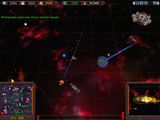 Among the most
noticeable changes is the new three-dimensional movement grid. By holding down the shift
key and moving the mouse up or down, you direct ships along the z-axis. In theory this is
a nice change, since real space battles would include all three dimensions; in practice,
however, the actual game play isn’t affected much. The point of view still hovers
above a playing grid that functions most easily in two dimensions. There is even a
drawback to playing on the z-axis in the form of distortions in perspective, as ships on
the bottom are so small they become difficult to see at even the highest resolutions,
while ships at the top occupy considerable screen space, even when the camera is zoomed
all the way out. The z-axis is reportedly ideal for network competition, in which
it’s possible to trick opponents concerning how many and what kind of ships you have
by hiding some at the bottom of the z-axis and covering them with ships up top. But in
single player mode, the z-axis provides minimal entertainment and few practical
advantages.
Among the most
noticeable changes is the new three-dimensional movement grid. By holding down the shift
key and moving the mouse up or down, you direct ships along the z-axis. In theory this is
a nice change, since real space battles would include all three dimensions; in practice,
however, the actual game play isn’t affected much. The point of view still hovers
above a playing grid that functions most easily in two dimensions. There is even a
drawback to playing on the z-axis in the form of distortions in perspective, as ships on
the bottom are so small they become difficult to see at even the highest resolutions,
while ships at the top occupy considerable screen space, even when the camera is zoomed
all the way out. The z-axis is reportedly ideal for network competition, in which
it’s possible to trick opponents concerning how many and what kind of ships you have
by hiding some at the bottom of the z-axis and covering them with ships up top. But in
single player mode, the z-axis provides minimal entertainment and few practical
advantages.
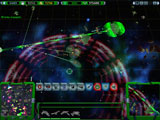 The player control interface functions smoothly and is
surprisingly intuitive. The detailed interactive tutorial is an enormous help, too. Each
press of a button is accompanied by those neat Star Trek bleeps, which adds an absurd yet
undeniable feeling of authenticity to manipulating the controls. The accompanying
soundtrack is appropriate to the mood and unobtrusive to game play, though it’s also
on a fairly short loop. Order acknowledgments are as repetitive as they get in any RTS and
don’t become annoying, with the possible exception of Jean Luc Picard constantly
ordering LaForge to reroute auxiliary power here and there. Shouldn’t LaForge already
know to do that? He didn’t go to Starfleet Academy to have some micro-managing
Frenchie tell him how to do his job, Picard, so lay off.
The player control interface functions smoothly and is
surprisingly intuitive. The detailed interactive tutorial is an enormous help, too. Each
press of a button is accompanied by those neat Star Trek bleeps, which adds an absurd yet
undeniable feeling of authenticity to manipulating the controls. The accompanying
soundtrack is appropriate to the mood and unobtrusive to game play, though it’s also
on a fairly short loop. Order acknowledgments are as repetitive as they get in any RTS and
don’t become annoying, with the possible exception of Jean Luc Picard constantly
ordering LaForge to reroute auxiliary power here and there. Shouldn’t LaForge already
know to do that? He didn’t go to Starfleet Academy to have some micro-managing
Frenchie tell him how to do his job, Picard, so lay off.
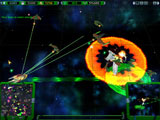 A new line of interesting special weapons makes its debut, along
with new settings allowing the computer to control when ships deploy these weapons. There
are three settings in this regard, from manual special weapons fire only, through allowing
the computer to fire when the ship has twice the energy required for one burst, to having
the computer fire as soon as sufficient energy has been stored. That’s not to say the
computer will target the most efficient enemy with its special weapons—the AI in that
respect is off. But you are saved from having to fire all special weapons by hand, and
with the fast pace of battles in Armada II, it’s a pleasure having one less thing to
worry about.
A new line of interesting special weapons makes its debut, along
with new settings allowing the computer to control when ships deploy these weapons. There
are three settings in this regard, from manual special weapons fire only, through allowing
the computer to fire when the ship has twice the energy required for one burst, to having
the computer fire as soon as sufficient energy has been stored. That’s not to say the
computer will target the most efficient enemy with its special weapons—the AI in that
respect is off. But you are saved from having to fire all special weapons by hand, and
with the fast pace of battles in Armada II, it’s a pleasure having one less thing to
worry about.
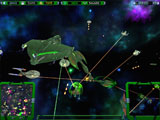 Not only are battles faster paced this time around, they seem to
be waged on a higher scale. Individual ships don’t last long in major battles, as all
computer-controlled enemies appear to target one ship at a time. Lower class vessels are
almost always destroyed after two battles, which means that Sovereign and Galaxy class
vessels are the ship of choice. These ships can be built only after you’ve collected
the necessary resources in metal, dilithium, and crew, as well as researching the required
knowledge and building the appropriate shipyards. The result of all this is a heavy
emphasis on infrastructure. Battle strategy may be vital to surviving the major conflicts,
but shrewd resource management has never been more important. Staking out and defending an
inexhaustible dilithium moon and a few choice planets could mean the difference between
victory and defeat.
Not only are battles faster paced this time around, they seem to
be waged on a higher scale. Individual ships don’t last long in major battles, as all
computer-controlled enemies appear to target one ship at a time. Lower class vessels are
almost always destroyed after two battles, which means that Sovereign and Galaxy class
vessels are the ship of choice. These ships can be built only after you’ve collected
the necessary resources in metal, dilithium, and crew, as well as researching the required
knowledge and building the appropriate shipyards. The result of all this is a heavy
emphasis on infrastructure. Battle strategy may be vital to surviving the major conflicts,
but shrewd resource management has never been more important. Staking out and defending an
inexhaustible dilithium moon and a few choice planets could mean the difference between
victory and defeat.
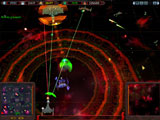 As for the ships themselves, one excellent addition is their
ability to travel at warp speed. The ships elongate and pass through the characteristic
white flash, which is fun to watch, and more importantly they travel three or four times
faster. Getting support to your attacking fleet is quicker now, and there’s less
waiting for ships to travel from one corner of the map to the other.
As for the ships themselves, one excellent addition is their
ability to travel at warp speed. The ships elongate and pass through the characteristic
white flash, which is fun to watch, and more importantly they travel three or four times
faster. Getting support to your attacking fleet is quicker now, and there’s less
waiting for ships to travel from one corner of the map to the other.
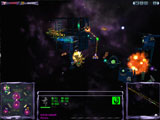 Graphics, on the other hand, are less than impressive. Space is
full of nebulas that affect your armada in various ways, from benign to devastating. The
colors of the nebulas are rich and vivid, though eventually they border on becoming an
eyesore. The detail of the ships themselves lacks precision, so that many vessels amount
to metallic gray blocks with jagged black lines to represent seams, windows, and weapon
arrays. However, there are nice touches like blinking lights on many ships, and from
enough of a distance they are all adequately rendered. And what the engine lacks in
graphics, it makes up for in diversity of perspectives. Unfortunately, most of the various
perspectives are awkward for the purposes of combat, and function better as cinematic
nuances.
Graphics, on the other hand, are less than impressive. Space is
full of nebulas that affect your armada in various ways, from benign to devastating. The
colors of the nebulas are rich and vivid, though eventually they border on becoming an
eyesore. The detail of the ships themselves lacks precision, so that many vessels amount
to metallic gray blocks with jagged black lines to represent seams, windows, and weapon
arrays. However, there are nice touches like blinking lights on many ships, and from
enough of a distance they are all adequately rendered. And what the engine lacks in
graphics, it makes up for in diversity of perspectives. Unfortunately, most of the various
perspectives are awkward for the purposes of combat, and function better as cinematic
nuances.
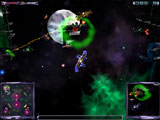 The voice acting and the cut scenes are standard fare, neither
impressive nor shameful. The game itself is much longer than the original, consisting of
forty-plus missions in the single player mode that covers four different races. Thorough
tutorials introduce the different races and their individual units, and each race has
sufficient advantages and disadvantages to establish a pleasing variety. However, the
story is a familiar one. The Borg are mounting an invasion and must be stopped at all
costs, for they represent a significant threat to life as we know it and blah blah blah.
Who knew when Q introduced the federation to the Borg how long this relationship would
last? If the Star Trek people aren’t careful, the Borg are going to become Bud Abbott
to the federation’s Lou Costello.
The voice acting and the cut scenes are standard fare, neither
impressive nor shameful. The game itself is much longer than the original, consisting of
forty-plus missions in the single player mode that covers four different races. Thorough
tutorials introduce the different races and their individual units, and each race has
sufficient advantages and disadvantages to establish a pleasing variety. However, the
story is a familiar one. The Borg are mounting an invasion and must be stopped at all
costs, for they represent a significant threat to life as we know it and blah blah blah.
Who knew when Q introduced the federation to the Borg how long this relationship would
last? If the Star Trek people aren’t careful, the Borg are going to become Bud Abbott
to the federation’s Lou Costello.
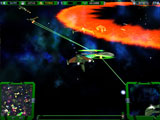 Finally, I would be remiss not to mention the terrible bugs I
encountered in Star Trek Armada II. Whenever I accomplished some objective, the game would
try to announce my success and elaborate in some way on what I accomplished, which was a
nice pat on the back. However, most of the time the transmission was hopelessly garbled,
or else the computer decided to send only half of every other word. There were also
moments when the screen became pixilated or otherwise unreadable. Reloading the game would
usually fix these malfunctions, as well as try my patience. I have read reports of Armada
II crashing out on other systems. It might be a matter of trying to find the right video
driver for your card, or else waiting for a patch. The game was perfectly playable with my
Hercules GeForce II; I just had to endure the occasional garbled message.
Finally, I would be remiss not to mention the terrible bugs I
encountered in Star Trek Armada II. Whenever I accomplished some objective, the game would
try to announce my success and elaborate in some way on what I accomplished, which was a
nice pat on the back. However, most of the time the transmission was hopelessly garbled,
or else the computer decided to send only half of every other word. There were also
moments when the screen became pixilated or otherwise unreadable. Reloading the game would
usually fix these malfunctions, as well as try my patience. I have read reports of Armada
II crashing out on other systems. It might be a matter of trying to find the right video
driver for your card, or else waiting for a patch. The game was perfectly playable with my
Hercules GeForce II; I just had to endure the occasional garbled message.
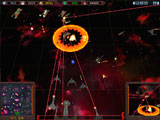 Fans of the RTS genre will likely find enough in Star Trek Armada
II to entertain them. The game functions smoothly, isn’t bad to look at, has
competent voice acting, and a viable—if stale—storyline. If you have some time
between this weekend’s convention and episodes of Voyager and Enterprise, you could
do worse than pick up Armada II.
Fans of the RTS genre will likely find enough in Star Trek Armada
II to entertain them. The game functions smoothly, isn’t bad to look at, has
competent voice acting, and a viable—if stale—storyline. If you have some time
between this weekend’s convention and episodes of Voyager and Enterprise, you could
do worse than pick up Armada II.
